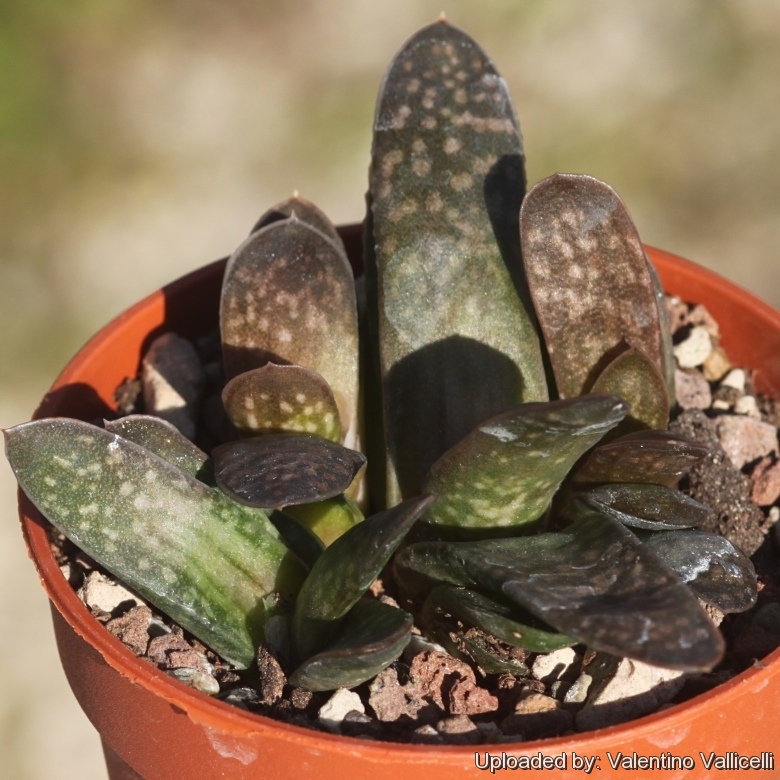Accepted Scientific Name: Gasteria nitida (Salm-Dyck) Haw.
Philos. Mag. Ann. Chem. 2: 358 1827.

Gasteria obtusa Photo by: Valentino Vallicelli
Origin and Habitat: Gamtoos River and adjacent areas in the coastal regions of Eastern Cape, South Africa.
Habitat: Rocky flat terrain.
Synonyms:
See all synonyms of Gasteria nitida
back
Accepted name in llifle Database:Gasteria nitida (Salm-Dyck) Haw.Philos. Mag. Ann. Chem. 2: 358 1827.Synonymy: 25
Accepted name in llifle Database:Gasteria nitida var. armstrongii (Schönland) van Jaarsv.Aloe 29(1): 12, 28 (1992)Synonymy: 6
back
Common Names include:
ENGLISH: Oxs' Tongue
Description: Gasteria obtusaSN|1479]]SN|1479]] (synonym of Gasteria nitidaSN|1476]]SN|1476]] var. nitida) is a dwarf distichous plant with dark green, spotted leaves. It is a popular species introduced in cultivation about in 1820.
Stem: Acaulescent or very short and stocky (2-5 cm long).
Roots: Thick, fusiform and succulent, with little branching, and endowed with the ability to contract, physically pulling the plant down into the ground during dry weather.
Rosettes: Distichous (growing in two planes only), grading into the rosulate form as plants ages, more or less pressed into the soil, rarely more than 20 cm in overall length in the wild, but quite variable in size and shape especially in cultivation. Old specimens cluster naturally with new plants around the original. It is slow growing. Mature and juvenile Gasteria obtusaSN|1479]]SN|1479]] often differ markedly.
Leaves: 12-18 tongue-like, 5-15 (rarely more) cm long, up to 3,5 cm broad and 1,2 cm thick, inner ascending, outer spreading, concave on the upper face, obliquely keeled down the back, dark glossy-green that can take maroon-red colouring in full sun, with prominent immersed paler spots in transverse rows, the leaf ends are obtuse (hence the species name)and mucronate. Margin cartilaginous entire or minutely toothed. Variegated forms with heavy bands of whitish-yellow markings on the green leaves are also known in cultivation.
Flowers: The inflorescences are simple 30 to 50(-90) cm tall and unbranched. Flowers pendulous, 20-25 mm long, pinkish-red, stomach-shaped for about half of the perianth length. Pedicel 6-10 mm long; bracts small lanceolate; perianth less than 25 mm long; ball about 6 mm in diameter, tube paler. Perianth segments obtuse recurved, vein greenish, tips yellowish-green.
Blooning season: It flowers in summer.
Fruits: Oblong about 25 x 8 mm wide.
Subspecies, varieties, forms and cultivars of plants belonging to the Gasteria nitida group
Bibliography: Major references and further lectures
1) Harvey, William H. Sonder, Otto Wilhelm, Thiselton-Dyer, William “Flora capensis: being a systematic description of the plants of the Cape colony, Caffraria, & Port Natal (and neighbouring territories)” v. 6 Page 298 1896-1897
Cultivation and Propagation: Gasterias are of easy cultivation and relatively low maintenance, which makes them a good houseplant, and can be excellent subjects for the beginning succulentophile (they can grow easily on window sills, verandas and in miniature succulent gardens where they are happy to share their habitat with other smaller succulent plants, or in outdoor rockeries).
Growth rate: They are relatively slow-growing plants that offsets to form small clusters with time.
Soil: They are tolerant of a wide range of soils and habitats, but prefer a very porous potting mix to increase drainage. A non-acid soil is ideal. You can grow a plant in a 10-15 cm pot for years and have perfectly happy plants. For best results, use a shallow pot.
Exposition: The plant needs light shade to shade, but will take full sun part of the day. (with some sun exposure the leaf develops a nice reddish tint and remains compact)
Watering: During the hot summer months, the soil should be kept moist but not overly wet. During the winter months, water only when the soil becomes completely dry. Wet soil quickly causes root and stem rot, especially during chilly winter months. No water should ever be allowed to stand around the roots. Low ambient humidity is always needed.
Fertilization: The plants are fertilized only once during the growing season with a balanced fertilizer diluted to ½ the recommended strength.
Hardiness: Although the plant will survive mild frost if kept dry (hardy as low as -5° C) it should be protected from severe cold and prolonged frost conditions.
Rot: Rot is only a minor problem with gasterias if the plants are watered and “aired” correctly. If they are not, fungicides won't help all that much. Care must be given in watering, keeping them warm and wet while growing, and cooler and dry when dormant.
Remarks: Gasterias are best planted in a shaded and airy part of the greenhouse, and not too close to the glass roof or sides of the house as the plants can overheat during hot spells.
Propagation: Gasterias are easily propagated by the removal of offshoots in spring or summer. They can also be grown from seed.










